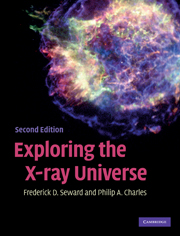Book contents
- Frontmatter
- Contents
- List of acronyms
- Foreword
- Chapter 1 Birth and childhood of X-ray astronomy
- Chapter 2 X-ray emission and interaction with matter
- Chapter 3 Tools and techniques
- Chapter 4 Solar system X-rays
- Chapter 5 X-ray absorption and scattering in the Interstellar Medium
- Chapter 6 Active stellar coronae
- Chapter 7 Early-type stars
- Chapter 8 Supernova explosions and their remnants
- Chapter 9 Neutron stars, pulsars, pulsar wind nebulae, and more supernova remnants
- Chapter 10 Cataclysmic variable stars
- Chapter 11 X-ray binaries
- Chapter 12 Black-hole X-ray binaries
- Chapter 13 Normal and starburst galaxies
- Chapter 14 Active galactic nuclei
- Chapter 15 Clusters of galaxies
- Chapter 16 The diffuse X-ray background
- Chapter 17 Gamma-ray bursts
- Index
- Plate section
Chapter 13 - Normal and starburst galaxies
Published online by Cambridge University Press: 05 June 2012
- Frontmatter
- Contents
- List of acronyms
- Foreword
- Chapter 1 Birth and childhood of X-ray astronomy
- Chapter 2 X-ray emission and interaction with matter
- Chapter 3 Tools and techniques
- Chapter 4 Solar system X-rays
- Chapter 5 X-ray absorption and scattering in the Interstellar Medium
- Chapter 6 Active stellar coronae
- Chapter 7 Early-type stars
- Chapter 8 Supernova explosions and their remnants
- Chapter 9 Neutron stars, pulsars, pulsar wind nebulae, and more supernova remnants
- Chapter 10 Cataclysmic variable stars
- Chapter 11 X-ray binaries
- Chapter 12 Black-hole X-ray binaries
- Chapter 13 Normal and starburst galaxies
- Chapter 14 Active galactic nuclei
- Chapter 15 Clusters of galaxies
- Chapter 16 The diffuse X-ray background
- Chapter 17 Gamma-ray bursts
- Index
- Plate section
Summary
X-ray sources in the Milky Way
Our Galaxy, the Milky Way, is a ‘normal’ spiral galaxy. It does not have a currently active nucleus (see Chapter 14), nor is it unusually luminous at any wavelength. Since we live in it, we find this a pleasing situation.
The first X-ray sources discovered within our Galaxy were naturally the brightest: the accretionpowered binaries. As time progressed, other Milky Way objects were also found to emit X-rays. Most of the emission from our Galaxy seemed to be from discrete objects, not from some galacticsized diffuse region. This is also true for most other ‘normal’ galaxies. The populations of discrete sources in other galaxies is a major topic of interest. For any particular class of source we would like to know how the number of sources varies with X-ray luminosity. This function, the XLF, can be compared with theoretical results concerning the nature and evolution of the sources.
The most luminous galactic X-ray sources are the accretion-powered binaries, which consist of a compact object and a companion star. If the companion is spectral type A or later (mass <~1 M⊗), the system is a low-mass X-ray binary or LMXB. If the companion is spectral-type O or B (mass >~10 M⊗), the system is a high-mass X-ray binary or HMXB (Chapter 11).
Luminosities range from very low up to ~ 1038 ergs s−1. Those with high luminosity are thought to be operating close to the Eddington limit, where the pressure of in-falling material is balanced by the pressure of outflowing radiation.
- Type
- Chapter
- Information
- Exploring the X-ray Universe , pp. 258 - 276Publisher: Cambridge University PressPrint publication year: 2010



